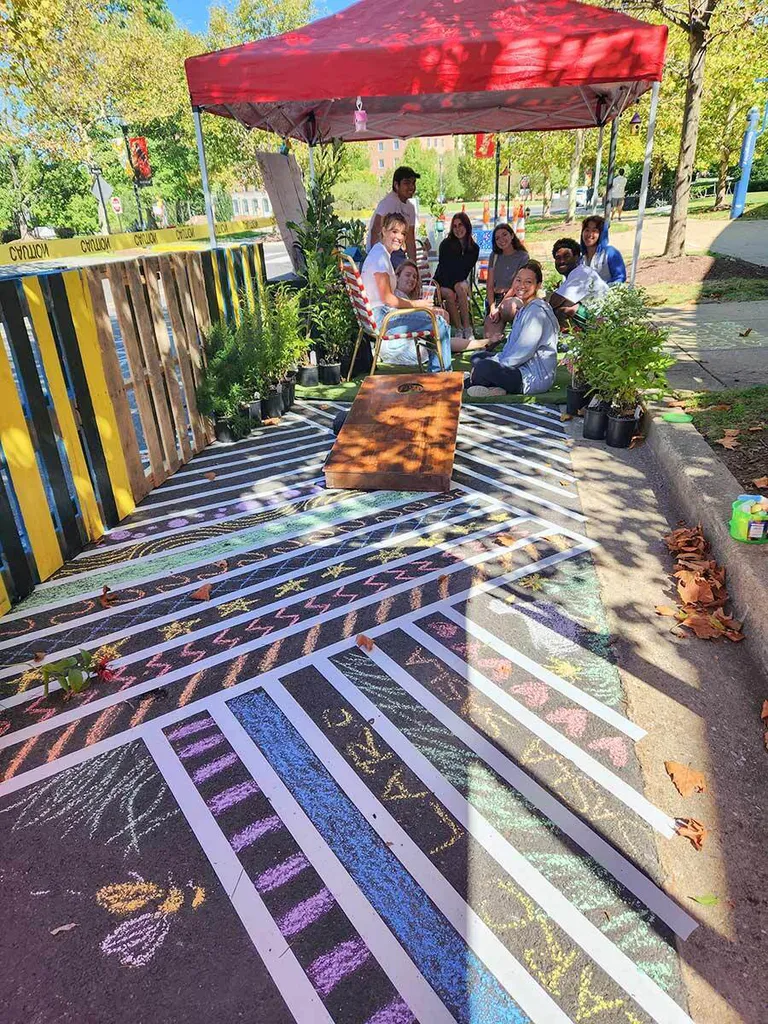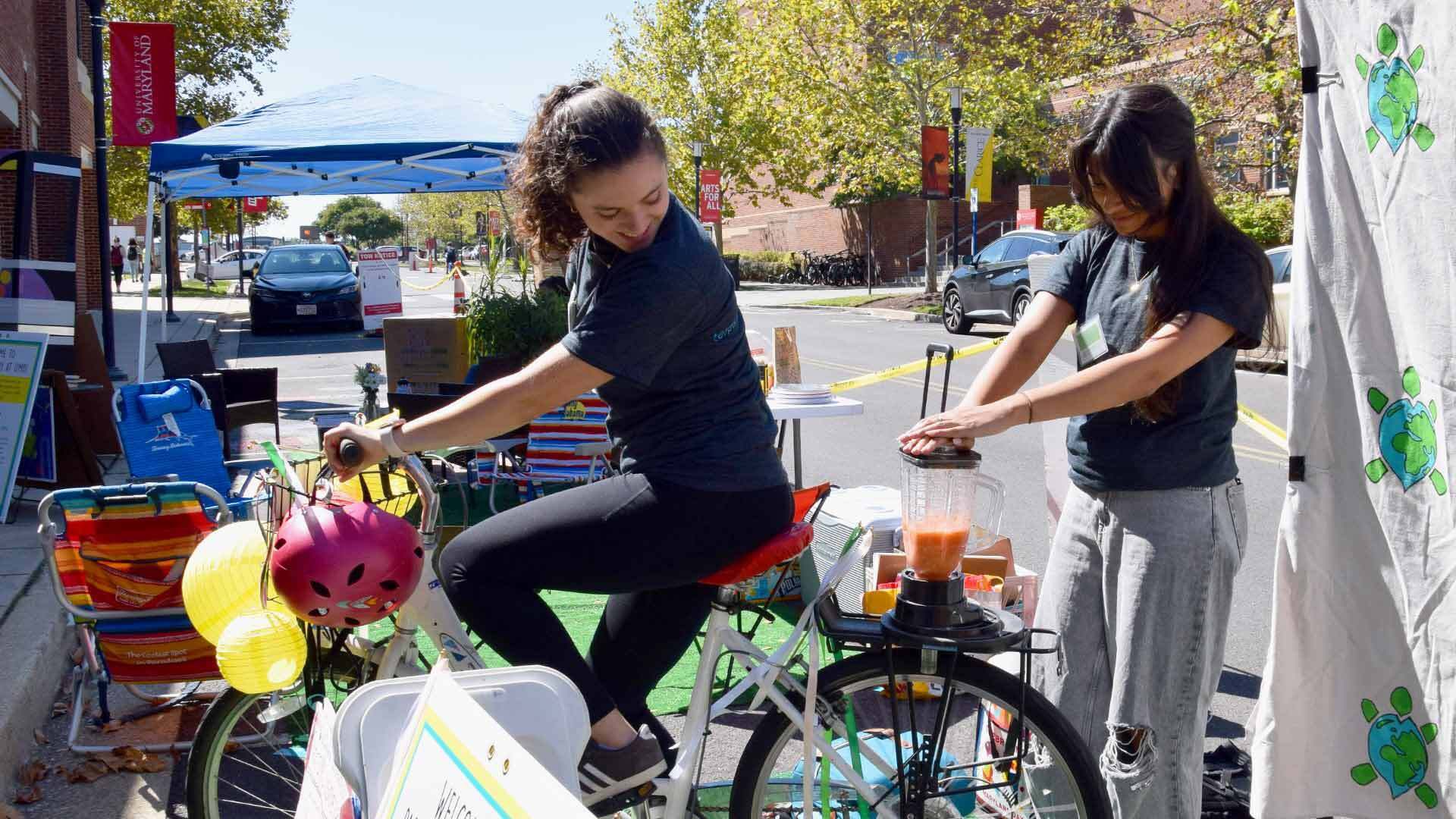- September 20, 2024
- By Maggie Haslam
Some of the University of Maryland’s biggest parties during football season originate out of the back of a car. But a block-long bash along Preinkert Drive on Friday proves you don’t need a tailgate to congregate—and might change your perspective on the prime real estate reserved for cars.
Park(ing) Day, a guerilla-style appropriation of asphalt, transforms street parking into lounge spaces, mini gardens and pop-up parks for one day to demonstrate how we might re-envision our campus roadways. Held in over 300 locations around the world, Park(ing) Day advocates for safer, greener and more equitable streets.
Here’s what you can expect if you pull into UMD’s event along Preinkert Drive:
- Giveaways, including Black-Eyed Susan seed packets from the student chapter of the American Society of Landscape Architects and a chance to win bike gear from Terps4Bikelanes.
- Free donut holes and a round of Rails and Roads, a riff off Chutes and Ladders, in the Student Planning Association’s game lounge.
- WMATA’s bus bike rack demo and Metro swag, where Terps can practice loading their bike onto a Metrobus.
- Registration for state carpool programs and IncenTrip, a sustainable rewards app developed by UMD researchers at the Maryland Transportation Institute. The program pays you up to $600 per year for responsible driving and sustainable transportation trips to work.
- DOTS Smoothie Bike: Toss your favorite fruit into the fender blender, created by the makers of the Bicycle Powered Music Festival, and pedal your way to a to-go healthy snack.

“The idea is to bring a little joy and color to our commutes around campus, but also to reaffirm that streets are for everyone, not just cars,” said Aysha Cohen, sustainable transportation coordinator for UMD’s Department of Transportation Services (DOTS). “Beyond 24/7 storage for cars, could parking spaces become something more interactive that connect us to one another?”
Department of Plant Science and Landscape Architecture students first spearheaded Park(ing) Day at UMD more than a decade ago; DOTS later adopted it as an annual event and now sponsors it. This year, student groups from urban studies and planning, landscape architecture, Terps4Bikelanes and other organizations—including WMATA and Prince George’s County Ride Smart program— have cooked up engaging and fun spaces that also educate about bike commuting around UMD, integrating native plants into streetscapes, public transit and carpooling resources.
Events like Park(ing) Day, said urban studies graduate student Maggi Currier, are the “rallying cry” to rethink street design to ease traffic, encourage different modes of travel and generally improve communities. It’s a critical issue in the U.S., she said, where cars have historically had the right of way; monster street-roadway hybrids (often called “stroads”), like Rockville Pike, promote high-speed traffic along unprotected bike lanes, narrow sidewalks and frequent curb cuts to access strip malls.
“Combining all these different elements make these routes hotspots for accidents,” said Currier. “We know we can’t snap our fingers and get rid of cars and parking, but what are we gaining by prioritizing the personal vehicle?”
Efforts to create safe, multimodal travel around campus are underway; beyond the progress on the state’s light-rail Purple Line, bike lanes have been added along Campus Drive, and new protected bike lanes were installed as part of DOTS’s Bikeways Project along Paint Branch Drive over the summer and neon green bike lanes now flank Baltimore Avenue. Designated bike lanes under construction along Lot 1 will open in 2025. In addition, the new lane configuration at Campus and Preinkert Drives near the Benjamin building transformed a stretch of asphalt to green space and an expansive sidewalk.
"We’re thinking about how we can manage our very constrained campus land in a more responsible, efficient and communal way," said Cohen.
UMD’s Park(ing) Day runs 10 a.m -3 p.m. Friday along Preinkert Drive (in front of Queen Anne’s Hall), featuring lounge spaces, giveaways, snacks and more.
For more two-wheeled fun, join BikeUMD at 8:30 a.m. Monday at Vigilante Coffee, 4327 Gallatin St. in Hyattsville for “Bikes and Beans.” Grab a coffee and jump on your bike for a scenic and beginner-friendly group ride to campus along the Trolley Trail to celebrate Car-Free Day. (Sign the Car-Free Day Pledge to help UMD win the Campus Challenge for a third consecutive year!)
